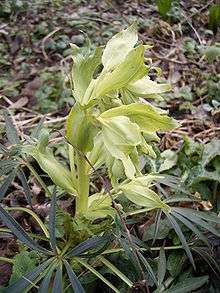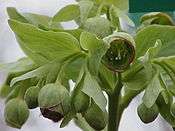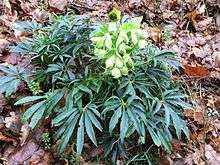Helleborus foetidus
Helleborus foetidus, known variously as stinking hellebore /ˈhɛlɪbɔːr/, dungwort, setterwort and bear's foot, is a species of flowering plant in the buttercup family Ranunculaceae, native to the mountainous regions of Central and Southern Europe, Greece and Asia Minor. It is found wild in many parts of England, especially on limestone soil.
| Helleborus foetidus | |
|---|---|
 | |
| Scientific classification | |
| Kingdom: | Plantae |
| Clade: | Tracheophytes |
| Clade: | Angiosperms |
| Clade: | Eudicots |
| Order: | Ranunculales |
| Family: | Ranunculaceae |
| Genus: | Helleborus |
| Species: | H. foetidus |
| Binomial name | |
| Helleborus foetidus | |
Description
It is an evergreen perennial growing to 80 cm (31 in) tall and 100 cm (39 in) across, with a thick succulent stem and glossy leaves. The drooping cup-shaped flowers appear in spring, and are yellowish-green, often with a purple edge to the five petal-like sepals on strongly upright stems. The flowers, typically for the family, contain numerous stamens as well as up to ten nectaries which make them attractive to bees and other insects. Each flower produces up to five (usually three) wrinkled follicles. Despite its common name, it is not noticeably malodorous, although the foliage is pungent when crushed.[1]
All parts of the plant are poisonous, containing glycosides. Symptoms of intoxication include violent vomiting and delirium.[1]
Yeasts colonise the nectaries of stinking hellebore and their presence has been found to raise the temperature of the flower, which may aid in attracting pollinators to the flower by increasing the evaporation of volatile organic compounds. It was the first species in which this effect was discovered.[2][3]
Horticulture

H. foetidus is grown in gardens for its handsome evergreen foliage and large numbers of green, bell-shaped flowers borne in late winter. It prefers woodland conditions with deep, fertile, moist, humus rich, well-drained soil, and dappled shade. The species is, however, drought-tolerant. It often occurs naturally on chalk or limestone soils.
This plant has gained the Royal Horticultural Society's Award of Garden Merit.[4][5]
The cultivar 'Green Giant' has very bright green flowers and finely divided foliage; 'Miss Jekyll' has fragrant flowers, intensity varying with the time of day; 'Wester Flisk Group' has red-tinted leaves and stems and gray-green flowers; the 'Sierra Nevada Group' is dwarf, reaching 30 cm.
Propagation is by division or from seed, which can be prolific, naturalising well in ideal conditions. Rodents should be kept away from the garden since they depredate the seeds either when still in fruiting plants within the carpels or from the floor after seed release.[6]

References
- North, Pamela (1967). Poisonous plants and fungi in colour. Blandford Press & Pharmacological Society of Great Britain. OL 193794W.
- Barley, Shanta (10 February 2010). "Stinky flower is kept warm by yeast partner". New Scientist. Retrieved 10 February 2010.
- Herrera, Carlos; María I. Pozo (10 February 2010). "Nectar yeasts warm the flowers of a winter-blooming plant". Proceedings of the Royal Society B. 277 (1689): 1827–34. doi:10.1098/rspb.2009.2252. PMC 2871880. PMID 20147331.
- "Helleborus foetidus". RHS Plant Selector. Retrieved 6 August 2020.
- "AGM Plants - Ornamental" (PDF). Royal Horticultural Society. July 2017. p. 47. Retrieved 3 March 2018.
- Fedriani, JM; Rey, PJ; Garrido, JL; Guitian, J; Herrera, CM; Medrano, M; Sanchez-Lafuente, AM; Cerdá, X (2004). "Geographical variation in the potential of mice to constrain an ant-seed dispersal mutualism". Oikos. 105: 181–191. doi:10.1111/j.0030-1299.2004.12782.x. hdl:10261/40326. OCLC 808298507.
| Wikiversity has bloom time data for Helleborus foetidus on the Bloom Clock |
- "Helleborus foetidus L". Flora Europaea. Royal Botanical Garden Edinburgh. Retrieved 29 September 2014.
- Franklin Perring; Max Walters (1989). Macmillan field guide to British wildflowers. Macmillan. ISBN 978-0-333-44522-8.
- Flora, the gardener's bible. Ultimo, NSW, Australia: ABC books. 2006. OL 2373715W.
- Geoff Bryant; Tony Rodd; Kate Bryant (2005). Ultimate plant book. Collingwood, Victoria, Australia: CSIRO Publishing. OCLC 224966026.